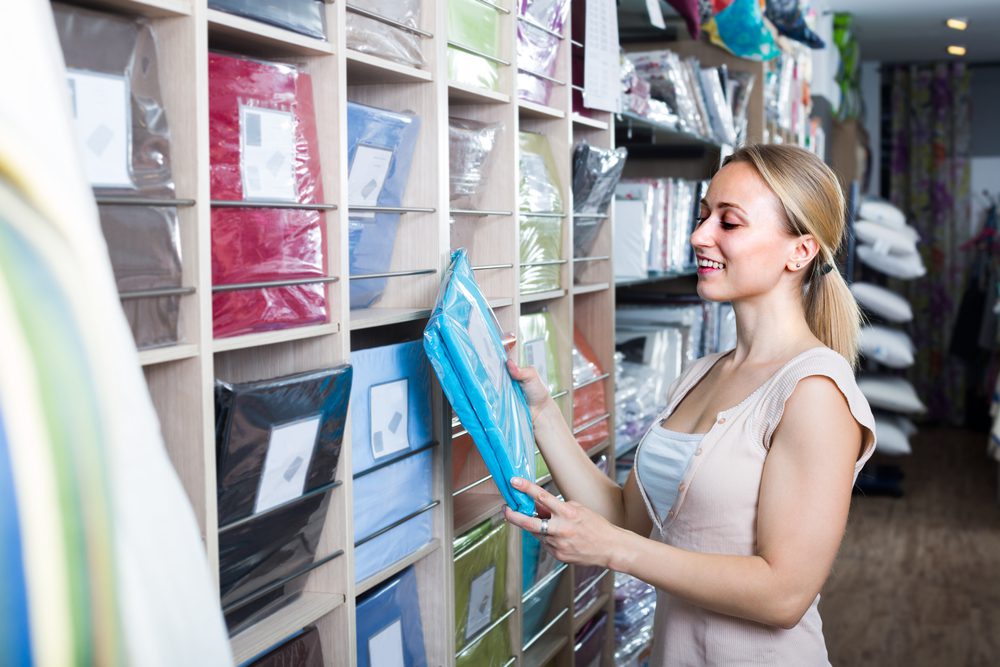Bamboo and cotton sheets may seem similar at first glance, since both use materials made from cellulose fibers, meaning they come from plants. However, there are some key differences that separate the two. We’ll take a look at how companies make bamboo and cotton sheets, what they cost, and how they perform.
What Are Bamboo Sheets?
Bamboo sheets are a soft and silky bedding option made with bamboo plant fiber. There are a few different types of bamboo-derived fabrics, with the most popular being rayon, viscose, modal, lyocell, and Tencel. Rayon and viscose are interchangeable terms. Modal is a type of rayon that is slightly stretchier than regular rayon, and Tencel is a brand of lyocell.
While manufacturing processes differ somewhat between materials, each of these fabrics start as bamboo pulp. Their feels vary slightly as well, though they all share common characteristics like breathability, softness, and durability.
To make bamboo sheets, bamboo plants are first cut down and beaten into pulp. Then, manufacturers use chemicals to extract cellulose from the pulp and turn it into a spinnable fiber. Lycocell, rayon, and modal all follow this process, while bamboo linen uses enzymes and washing instead of chemicals.
The main difference between rayon, lyocell, and modal is that modal production includes a stretching process that makes the fabric a bit more durable and lightweight than its counterparts.
Bamboo Linen: This type of bamboo-derived fabric is more rare and undergoes a mechanical rather than chemical process during manufacturing. While other bamboo-derived fabrics are made by breaking down the fiber with chemicals, making bamboo linen involves natural enzymes and washing. The resulting fiber is a bit more coarse and wrinkle-prone than rayon from bamboo fabrics.
Bamboo Rayon: Some retailers use the term bamboo rayon to refer to lyocell, modal, and rayon, since they’re all manufactured using the same method. Bamboo rayon is semi-synthetic, since chemicals are necessary to create the final product. This type of bamboo fabric is smoother than bamboo linen.
Though they’re created using different techniques, all bamboo-derived sheets have a similar smooth and soft feel that makes them a cost-effective alternative to silk. The fabric is breathable, strong, and typically machine-washable.
Breakdown of Bamboo Sheets
Sheet Type | Description | Pros | Cons |
|---|---|---|---|
Bamboo Linen | Bamboo-derived fabric created by mechanically breaking down bamboo pulp and turning it into thread |
|
|
Bamboo Rayon | Bamboo-derived fabric made using chemicals to turn pulp into thread |
|
|
Bamboo Sheet Weaves
Once bamboo becomes a spinnable fiber, it’s made into thread, which is then woven into fabric. Companies use different weaving patterns to achieve various effects and feels.
Percale: Percale sheets are crisp and airy, thanks to their one thread over, one thread under pattern. Since the threads are evenly dispersed, it’s easy for air to pass through the fabric, making them a good choice for hot sleepers. Percale sheets usually have a matte finish, and while they’re generally easy to care for, they do tend to wrinkle fairly easily.
Sateen: Sateen fabrics have an elegant sheen and luxe feel. They’re woven by placing one thread under and three or four threads over. The resulting fabric drapes easily and feels silky soft. However, sateen sheets aren’t as breathable as percale sheets, and the fabric is more prone to pilling.
Twill: This weave uses offset rows to create a diagonal pattern in the fabric. Twill is a durable material, which is why it’s often used in denim and upholstery. Twill sheets have more texture than other styles, so they’re unlikely to pill, though they may feel rough.
Are Bamboo Sheets Eco-Friendly?
Bamboo plants grow quickly and easily, often without the need for pesticides or fertilizer, which makes them great candidates for eco-friendly products.
However, bamboo-derived fabrics that use chemicals in their manufacturing can produce harmful waste. This applies to rayon, viscose, lyocell, and modal fabrics. The related chemical byproducts can be detrimental to workers and the environment if not properly disposed of.
Bamboo Linen is more eco-friendly, as the manufacturing process is a closed loop that reuses materials and doesn’t use chemicals.
What Are Cotton Sheets?
Made from fabric derived from cotton plants, cotton sheets are airy and soft. There are three types of cotton used to make sheets: pima, Egyptian, and upland.
Staple length is an important factor to consider when choosing between cotton varieties, and it’s one of the greatest differences between the three types. Staple length refers to a fiber’s average length. Generally, the longer a fiber’s staple length, the softer it feels and the more durable it is. When spun into thread, short-staple fibers aren’t totally smooth, which makes the fabric feel a bit rougher than fabric made from long-staple fiber. However, cotton sheets can offer top-notch comfort and durability regardless of the type of cotton used or its staple length.
Breakdown of Cotton Sheets
Sheet Type | Description | Pros | Cons |
|---|---|---|---|
Cotton | Fabric that’s made of woven fiber from cotton plants |
|
|
Types of Cotton Sheets
Cotton sheets are available in multiple styles and weaves, which makes them one of the most versatile options when it comes to choosing the best sheets.
Upland Cotton: Upland cotton is the most widely purchased type of cotton in the U.S., thanks to its affordability. It’s native to the Americas but can be grown in multiple climates. As a result, the vast majority of the cotton grown worldwide is upland cotton. Its short- to medium-staple length makes it well-suited to many products, including sheets.
Egyptian Cotton: Egyptian cotton has an extra-long staple length that gives it a soft and luxurious feel. Certified Egyptian cotton is only grown in the Nile River delta. It’s synonymous with quality and often costs more than other types of cotton. Egyptian cotton sheets also often have a high thread count, which can make them even more comfortable and durable.
Pima Cotton: Pima cotton is actually the same species of cotton as Egyptian cotton, but it’s generally grown in the Southwestern U.S. It has the same extra-long staple length as Egyptian cotton, leading it to feel comparably luxe, soft, and durable.
What Are Luxury Cotton Sheets?
Luxury cotton sheets have long- or extra-long staple lengths that make the fabric both soft and durable.
Before considering luxury cotton sheet weaves or thread count, look for certifications to ensure the manufacturer’s claims are accurate. Many sets are labeled Egyptian even if they only contain a small percentage of Egyptian cotton. Look for certifications from the Egyptian Cotton Association, which DNA tests cotton to certify its origins. In the case of Pima cotton, check the percentage of Pima cotton within the fabric or research where the cotton was grown.
Cotton Sheet Weaves
Once cotton fiber is spun into thread, manufacturers use many different weaving methods to achieve different feels.
Percale: With its one strand over, one strand under pattern, percale fabric feels crisp and breathable. This weave enhances the cotton’s ability to effectively wick moisture, making percale sheets one of the best options for hot sleepers. They’re also easy to launder and typically become softer after multiple washes.
Sateen: Cotton sheets with a sateen weave drape easily and feel exceptionally soft. When woven, the threads follow a pattern of one strand under and three or four over. The result has a somewhat shiny look that’s comparable to silk.
Twill: Though they aren’t as soft as sateen or percale styles, twill sheets are incredibly durable. Twill uses offset ribbing that gives a diagonal or herringbone-like appearance. This weave is most often used in denim or upholstery.
Jersey: While woven fabrics have more structure, knit fabrics have more stretch. Cotton jersey is significantly stretchier than woven fabrics, and it feels similar to a T-shirt.
Are Cotton Sheets Eco-Friendly?
Cotton sheets can be eco-friendly if manufacturers take care to use sustainable practices. Cotton requires large amounts of water during cultivation, and many farmers use pesticides and fertilizers. Choosing organic cotton certified by the Global Organic Textile Standard (GOTS) can help mitigate these problems, as can buying products made from recycled cotton.
Shop the Best Sheets of 2024What Is the Difference Between Bamboo and Cotton Sheets?
Bamboo and cotton sheets are both excellent options for sleepers looking for something soft yet durable. They’re versatile, easy-to-clean fabrics that are available in a wide variety of weaves at many different price-points. However, they have their differences.
Cotton sheets tend to be a bit more breathable and airy than bamboo sheets, while bamboo-derived fabrics often have a silkier feel than cotton. On average, cotton sheets are more affordable than bamboo sheets, though high-end cotton sheets can also be quite expensive.
When it comes to sustainability, bamboo-derived fabrics are more often touted as eco-friendly, though companies do use chemicals during manufacturing. Cotton requires significantly more water than bamboo during its growth, but finding sustainable organic cotton sheets is fairly easy.
Bamboo vs. Cotton Sheets
Category | Bamboo | Cotton |
|---|---|---|
Price | With price-points that span from $50 to $200, bamboo sheets tend to be more expensive than cotton sheets. | Sets start at $50 or less, making cotton one of the most affordable options for sheets. However, luxury cotton sheets can run as high as $600. |
Cleaning and Care | Bamboo sheets are very easy to launder, though it’s best to remove them from the dryer immediately to prevent wrinkles. | Though high heat can cause them to shrink, cotton sheets are generally very simple to launder. |
Wear and Tear | Bamboo-derived fabrics are highly durable. | Cotton sheets are also long-lasting, though you may want to spend a little more for sheets made from long-staple cotton, which can last even longer. |
Feel and Performance | Bamboo-derived fabric feels comparable to silk, and it drapes very similarly. While different weaves have different hand feels, bamboo sheets are usually soft and cool to the touch. | Cotton is highly breathable and can be very soft, depending on weave. |
Temperature Control | Bamboo sheets allow for substantial airflow and sleep quite temperature-neutral, though the hottest sleepers may prefer cotton. | Cotton both circulates air and wicks moisture, making it one of the best fabrics for temperature control. |
Get Your Sleep Questions Answered Live on 4/30
Have questions about sleep? Get all your sleep-related questions answered in a Live Q&A on YouTube with renowned sleep expert Dr. Michael Breus at 5 p.m. PST/8 p.m. EST.







